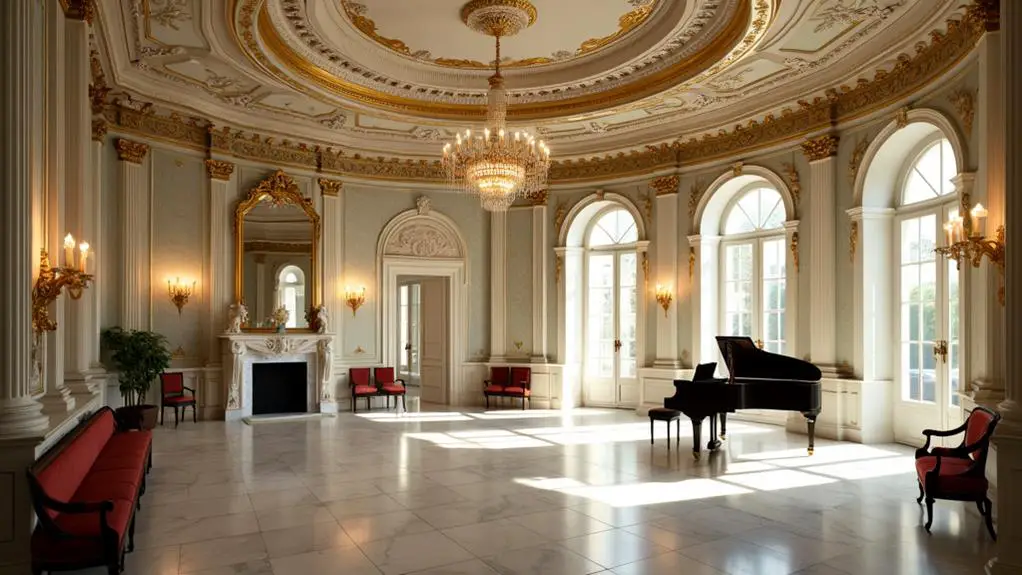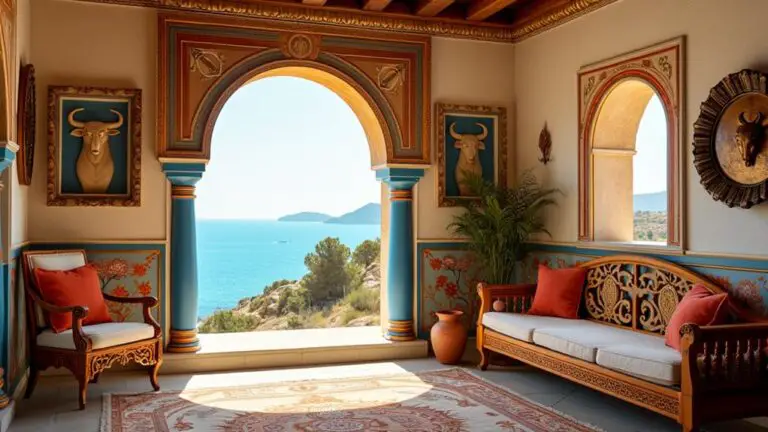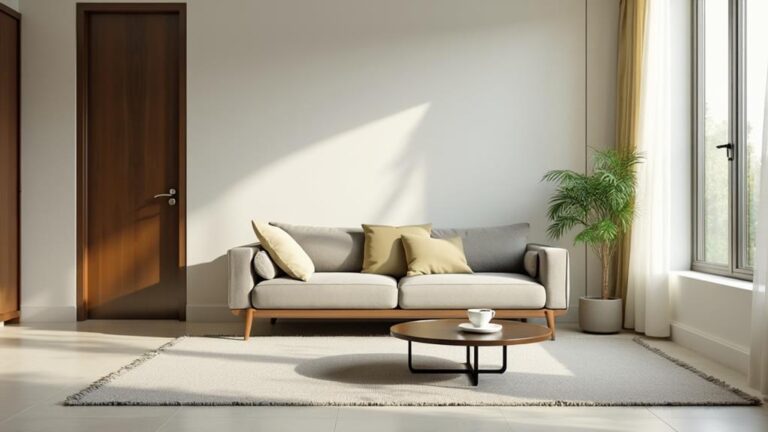Neoclassical Nobility: Refined and Elegant Room Designs
I'm captivated by Neoclassical design's ability to create refined, elegant spaces. It's all about symmetry, balance, and timeless beauty. I love how it combines soft, muted colors with rich accents and luxurious materials like marble and silk. The clean lines of furniture and architectural details like columns add a sense of grandeur. When decorating in this style, I focus on creating a harmonious arrangement with matching pairs and classical accessories. Modern interpretations blend traditional elements with contemporary touches, keeping the look fresh. There's so much more to explore in the world of Neoclassical nobility and its enduring appeal.
What To Know
- Incorporate symmetrical layouts with balanced furniture arrangements to evoke a sense of nobility and order.
- Use a soft color palette of creams, greys, and beiges, accented with rich hues like navy or deep green.
- Feature architectural elements like columns, pediments, and ornate moldings to enhance the room's refined character.
- Select high-quality furnishings with clean lines and geometric shapes, crafted from luxurious materials like mahogany or marble.
- Add classical decorative accents such as gilded mirrors, sculptures, and urns to infuse elegance and grandeur into the space.
Origins of Neoclassical Design

From out of the opulent excesses of Baroque and Rococo styles emerged Neoclassical design in mid-18th century Europe.
I've always been fascinated by how this movement arose as a reaction to the ornate decor that preceded it. The origins of neoclassical design can be traced to the rediscovery of ancient Greek and Roman architecture, sparked by archaeological findings in Pompeii and Herculaneum.
This newfound appreciation for classical antiquity led to a shift towards simplicity, symmetry, and elegance in decor. As I've studied the style, I've come to admire its clean lines, classical motifs, and muted color palette.
The emphasis on refined craftsmanship and natural materials reflects a cultural desire for timeless beauty. It's remarkable how neoclassical design gained popularity among the elite, aligning with democratic ideals and continuing to influence aesthetics well into the 19th century.
Essential Elements and Principles

Several essential elements and principles define the neoclassical room design. I've found that symmetry and balance are paramount, with furniture arrangements often mirroring each other around a central focal point.
The color palette typically embraces soft, muted tones like cream and light gray, accented with rich hues such as deep blue or gold for added elegance.
Key architectural details, including columns and pediments, are integral to neoclassical interior design. I've noticed that furnishings feature clean lines and simple geometric forms, often incorporating luxury materials like silk and velvet for refined sophistication.
Decorative accessories, such as classical sculptures and urns, play a vital role in enhancing the room's grandeur. By combining these elements, I can create a space that exudes timeless elegance, balancing traditional motifs with a sense of refined luxury and visual harmony.
Color Palettes and Materials

Building on the foundational elements of neoclassical design, the color palette and materials used play a key role in creating the signature ambiance of these elegant spaces. I've found that muted tones like soft grey, cream, and beige form the base of neoclassical color palettes, while darker hues serve as accents. Natural materials, including wood and marble, contribute to the timeless quality of these interiors.
| Element | Characteristics |
|---|---|
| Color Palette | Soft, muted tones |
| Accents | Navy blue, deep green, burgundy |
| Materials | Wood, marble, stone |
| Textiles | Silk, velvet, damask |
| Metallics | Gold and silver accents |
To enhance the sophisticated atmosphere, I incorporate luxurious fabrics like silk and velvet. Gold accents add a touch of opulence without overwhelming the understated elegance that defines neoclassical room designs.
Furnishings and Decorative Accents

Furnishings and decorative accents in neoclassical room designs play a pivotal role in bringing the style's elegance to life.
I've found that high-quality materials like mahogany and marble are essential in creating the refined look of neoclassical interior design. The use of clean lines and geometric silhouettes in furniture pieces adds a timeless appeal.
To enhance the room's elegance and symmetry, I often incorporate:
- Matching pairs of chairs or nightstands
- Ornate mirrors and gilded frames
- Classical sculptures and decorative urns
These elements not only create visual harmony but also reflect the style's ancient Greek and Roman influences.
I'm particularly fond of using luxurious fabrics like silk and velvet in muted tones for upholstery and drapery. The overall effect is a sophisticated space that exudes elegance and timelessness.
Modern Interpretations and Applications

Modern neoclassical design has evolved to embrace contemporary aesthetics while maintaining its timeless elegance.
I've observed how designers blend traditional architectural elements with contemporary furnishings, creating spaces that feel both classic and current.
Neutral color palettes with muted tones and metallic accents are often used to evoke neoclassical interior design's sophistication.
I've noticed that furniture typically features clean lines and minimal ornamentation, allowing for seamless integration of modern pieces.
Abstract art and sleek lighting fixtures add a fresh twist to decorative motifs, enhancing the overall aesthetic.
Luxury materials like marble, silk, and fine woods remain essential, preserving the essence of opulence.
Conclusion
I've fallen in love with neoclassical design's timeless elegance. It's like a refreshing change in today's chaotic world. By embracing its refined principles, I can create spaces that exude nobility and grace. Whether I'm working with traditional elements or modern interpretations, the essence of neoclassicism shines through. It's a style that'll never go out of fashion, always ready to transport us to an era of sophistication and grandeur.







